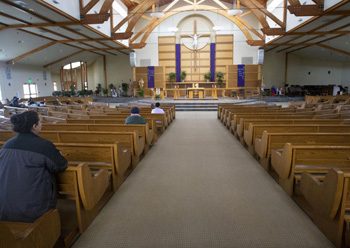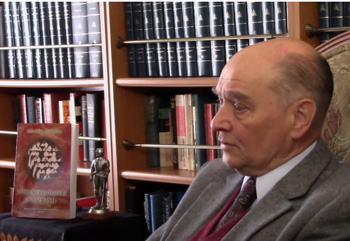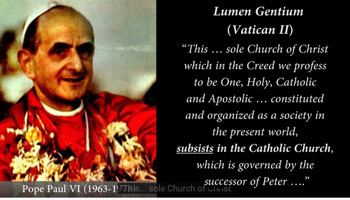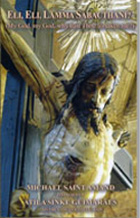Consequences of Vatican II
 |
 |
 |
 |
 |
 |
 |
The Crisis in the Church – Part I
An Abbreviated Explanation
In 1884, while celebrating Mass, Pope Leo XIII had a horrifying vision of a conversation between the Devil and Our Lord Jesus Christ. The Devil asked for 100 years to destroy the Church, and Our Lord responded by saying, “You have the time, you will have the power.” (1)
 It is no secret that the Church is in crisis. On any given week, only about 39% of Catholics attend Mass, down from 75% in 1955. (2) Most parishioners enter casually dressed and apathetic.
Furthermore, the majority of self-professed Catholics do not agree with Church teachings: 76% support contraceptives; 54% are in favor of same-sex unions; 53% say abortion should be legal, to give only a few examples. (3)
It is no secret that the Church is in crisis. On any given week, only about 39% of Catholics attend Mass, down from 75% in 1955. (2) Most parishioners enter casually dressed and apathetic.
Furthermore, the majority of self-professed Catholics do not agree with Church teachings: 76% support contraceptives; 54% are in favor of same-sex unions; 53% say abortion should be legal, to give only a few examples. (3)
Worst of all, millions of Americans are leaving the Church altogether, so many that 13% of American adults identify as former Catholics. (4) These are only the quantifiable statistics. If we were to look, for example, at the decay of manners or the lack of seriousness among priests, we would discover that the crisis in the Church runs far deeper than it first appears.
Many books written about this crisis offer the simplistic solution: If more Catholics were to attend Mass and become involved in their parish communities, the problem will be solved. Yet, if the Church is not attracting people, is it because they have forgotten her, or perhaps because she has forgotten her way?
The crisis predicted by Our Lady
Our Lady herself has answered this question. She foresaw this crisis and spoke about it in numerous apparitions, including Our Lady of La Salette, Our Lady of Fatima and Our Lady of Akita.
Most important, and least known, are the apparitions of Our Lady of Good Success, which took place in Quito, Ecuador, in the late 16th and early 17th centuries, and have been approved by every Bishop of Quito.
 As Dr. Marian Horvat states in Part Two of the video, “Our Lady of Good Success: Prophecies for Our Times,” Our Lady appeared to a Conceptionist nun named Mother Mariana de Jesus Torres on January 21, 1610, and told her that “from the end of the 19th century to shortly after the middle of the 20th century, the passions will erupt, doctrine will be corrupted, and there will be a total corruption of customs.”
As Dr. Marian Horvat states in Part Two of the video, “Our Lady of Good Success: Prophecies for Our Times,” Our Lady appeared to a Conceptionist nun named Mother Mariana de Jesus Torres on January 21, 1610, and told her that “from the end of the 19th century to shortly after the middle of the 20th century, the passions will erupt, doctrine will be corrupted, and there will be a total corruption of customs.”
Here are a just a few of the many prophecies she made:
● “The spirit of the world will enter the religious sphere. Religious would abandon their rules and the spirit of their Orders”:
The religious vocation, especially for cloistered nuns, is meant to be a separation from the world. Therefore, nuns used to behave in a serious and recollected manner. Religious Orders had strict Rules that were strictly followed.
St. Therese of Lisieux writes in Story of a Soul about the Great Silence (the complete silences observed by Carmelites after the Compline). She mentions the Lenten fast, which in some Convents began in September and lasted until Easter, and the strict cloister, where nuns were only allowed to speak to guests through a grille and brief periods of time.
How much has changed! After Vatican II almost all Religious Orders relaxed or abandoned their Rules, eschewed their traditional habits in favor of pants, and now are even allowing the sisters to post selfies and videos online or participate in worldly events (Suor Cristina, an Italian nun who won The Voice and competed in Dancing with the Stars, is a notorious example).
 ● “The Sacraments would be abused and abandoned”:
● “The Sacraments would be abused and abandoned”:
It is becoming increasingly rare for parents to baptize their children or take them to Mass. Those who do attend Mass tend to avoid going to Confession, despite the fact that weekly Confession used to be common practice. Now, there are millions of people receiving the Holy Eucharist in a state of mortal sin.
● “A great immorality would invade the clergy and many priests would be unworthy of their office”:
The sexual abuse scandals are, of course, evidence of this, and new scandals and cover-ups continue to be discovered. It is becoming very difficult to trust priests.
The flaws of Vatican II
The Second Vatican Council, which began in 1962, is the major landmark of the crisis in the Church. In fact, Mother Mariana de Jesus Torres predicted not only the particulars of the crisis in the Church to come, but also with great precision its cause: She pinpointed a first crisis – which was that of Modernism – to break out at the end of the 19th century. The second and greater crisis, she foretold, would erupt a little after the middle of the 20th century – the exact time of Vatican II.
The Council had the explicit aim to make the Church fit in with the modern world. Though hotly contested, Vatican II is not infallible as it did not proclaim anything as dogma. Paul VI, who presided over the Council, affirmed: “In view of the pastoral nature of the Council, it avoided any extraordinary statement of dogmas that would be endowed with the note of infallibility.” (5)
Here is a short summary of some of the Council’s flaws:
● The Second Vatican Council used ambiguous language to obscure the unchangeable doctrines of the Holy Church:
Condemned as “the synthesis of all heresies” by Pope St. Pius X, Modernism aims to fundamentally shift the way Catholics view their Faith. It is relativistic, claiming that all religions are equal and calling into question basic truths, such as the inerrancy of Scripture and the divinity of Christ. (6)

 In his video “Vatican Council II, Explained,” Mr. Atila Guimarães demonstrates how the Second Vatican Council is infected by Progressivism, a subtler form of Modernism that is more difficult to detect. While most of the Council’s documents can be interpreted in an orthodox way, their ambiguous language gives rise to new, heretical understandings.
In his video “Vatican Council II, Explained,” Mr. Atila Guimarães demonstrates how the Second Vatican Council is infected by Progressivism, a subtler form of Modernism that is more difficult to detect. While most of the Council’s documents can be interpreted in an orthodox way, their ambiguous language gives rise to new, heretical understandings.
For example, Mr. Guimarães notes, the document Lumen Gentium, states that the Church of Christ “subsists in the Catholic Church.” This implies that the true Church is an invisible, larger mystical Body of Christ, of which the Catholic Church is only a part. This is heresy, for the Church of Christ is synonymous with the Catholic Church. However, supporters of the Council always have a line of defense: “Subsists in,” they argue, is simply a roundabout way of saying “is.”
Another example of ambiguous language is the Council’s implication that non-Catholic religions lead to salvation. In the Council of Florence, Pope Eugene IV clearly affirmed that all those who are outside the Catholic Church cannot have a share in eternal happiness… unless they unite themselves to the Church before their death.
Despite this, Vatican II’s document Unitatis Redintegratio says that “separated churches and communities, although we believe they suffer from the defects already mentioned, have been by no means deprived of significance and importance in the mystery of salvation. The Holy Spirit has by no means refrained from using them as a means of salvation.”
Again, it is ambiguous language, with an implication that persons in other religions can be saved. At the same time, the progressivists can respond to objectors, this quote could simply be saying that God can give graces to Protestants as one step in a person's journey to the Catholic Church, and not that their false religion is in itself salvific.
That said, it is clear how one could gain the wrong impression from reading this quote.
Continued


Empty pews in a church stripped of its beauty & sacrality by Vatican II
Worst of all, millions of Americans are leaving the Church altogether, so many that 13% of American adults identify as former Catholics. (4) These are only the quantifiable statistics. If we were to look, for example, at the decay of manners or the lack of seriousness among priests, we would discover that the crisis in the Church runs far deeper than it first appears.
Many books written about this crisis offer the simplistic solution: If more Catholics were to attend Mass and become involved in their parish communities, the problem will be solved. Yet, if the Church is not attracting people, is it because they have forgotten her, or perhaps because she has forgotten her way?
The crisis predicted by Our Lady
Our Lady herself has answered this question. She foresaw this crisis and spoke about it in numerous apparitions, including Our Lady of La Salette, Our Lady of Fatima and Our Lady of Akita.
Most important, and least known, are the apparitions of Our Lady of Good Success, which took place in Quito, Ecuador, in the late 16th and early 17th centuries, and have been approved by every Bishop of Quito.

Fr. Donald McGuire, Mother Teresa's spiritual director, was convicted of multiple crimes of pedophilia
Here are a just a few of the many prophecies she made:
● “The spirit of the world will enter the religious sphere. Religious would abandon their rules and the spirit of their Orders”:
The religious vocation, especially for cloistered nuns, is meant to be a separation from the world. Therefore, nuns used to behave in a serious and recollected manner. Religious Orders had strict Rules that were strictly followed.
St. Therese of Lisieux writes in Story of a Soul about the Great Silence (the complete silences observed by Carmelites after the Compline). She mentions the Lenten fast, which in some Convents began in September and lasted until Easter, and the strict cloister, where nuns were only allowed to speak to guests through a grille and brief periods of time.
How much has changed! After Vatican II almost all Religious Orders relaxed or abandoned their Rules, eschewed their traditional habits in favor of pants, and now are even allowing the sisters to post selfies and videos online or participate in worldly events (Suor Cristina, an Italian nun who won The Voice and competed in Dancing with the Stars, is a notorious example).

Hosts passed out without care or reverence
at a World Youth Day
It is becoming increasingly rare for parents to baptize their children or take them to Mass. Those who do attend Mass tend to avoid going to Confession, despite the fact that weekly Confession used to be common practice. Now, there are millions of people receiving the Holy Eucharist in a state of mortal sin.
● “A great immorality would invade the clergy and many priests would be unworthy of their office”:
The sexual abuse scandals are, of course, evidence of this, and new scandals and cover-ups continue to be discovered. It is becoming very difficult to trust priests.
The flaws of Vatican II
The Second Vatican Council, which began in 1962, is the major landmark of the crisis in the Church. In fact, Mother Mariana de Jesus Torres predicted not only the particulars of the crisis in the Church to come, but also with great precision its cause: She pinpointed a first crisis – which was that of Modernism – to break out at the end of the 19th century. The second and greater crisis, she foretold, would erupt a little after the middle of the 20th century – the exact time of Vatican II.
The Council had the explicit aim to make the Church fit in with the modern world. Though hotly contested, Vatican II is not infallible as it did not proclaim anything as dogma. Paul VI, who presided over the Council, affirmed: “In view of the pastoral nature of the Council, it avoided any extraordinary statement of dogmas that would be endowed with the note of infallibility.” (5)
Here is a short summary of some of the Council’s flaws:
● The Second Vatican Council used ambiguous language to obscure the unchangeable doctrines of the Holy Church:
Condemned as “the synthesis of all heresies” by Pope St. Pius X, Modernism aims to fundamentally shift the way Catholics view their Faith. It is relativistic, claiming that all religions are equal and calling into question basic truths, such as the inerrancy of Scripture and the divinity of Christ. (6)

Atila Guimaraes points out ambiguities of language in the Council documents

For example, Mr. Guimarães notes, the document Lumen Gentium, states that the Church of Christ “subsists in the Catholic Church.” This implies that the true Church is an invisible, larger mystical Body of Christ, of which the Catholic Church is only a part. This is heresy, for the Church of Christ is synonymous with the Catholic Church. However, supporters of the Council always have a line of defense: “Subsists in,” they argue, is simply a roundabout way of saying “is.”
Another example of ambiguous language is the Council’s implication that non-Catholic religions lead to salvation. In the Council of Florence, Pope Eugene IV clearly affirmed that all those who are outside the Catholic Church cannot have a share in eternal happiness… unless they unite themselves to the Church before their death.
Despite this, Vatican II’s document Unitatis Redintegratio says that “separated churches and communities, although we believe they suffer from the defects already mentioned, have been by no means deprived of significance and importance in the mystery of salvation. The Holy Spirit has by no means refrained from using them as a means of salvation.”
Again, it is ambiguous language, with an implication that persons in other religions can be saved. At the same time, the progressivists can respond to objectors, this quote could simply be saying that God can give graces to Protestants as one step in a person's journey to the Catholic Church, and not that their false religion is in itself salvific.
That said, it is clear how one could gain the wrong impression from reading this quote.
Continued
- https://stjosephschurch.net/vision-of-pope-leo-xiii/ - https://www.traditioninaction.org/Questions/B649_Leo13.html
- https://catholicphilly.com/2018/05/catholic-spirituality/mass-attendance-is-down-again-but-among-whom/
- https://www.pewresearch.org/fact-tank/2013/09/19/majority-of-u-s-catholics-opinions-run-counter-to-church-on-contraception-homosexuality/
- https://www.pewresearch.org/fact-tank/2018/10/10/7-facts-about-american-catholics/
- Pope Paul VI, “After the Council: New Tasks”, The Pope Speaks, vol. 11 (Winter, 1966), p.154.
- https://www.youtube.com/watch?v=toWI_zn_aAg

Posted May 6, 2022
______________________
______________________
 Volume I |
 Volume II |
 Volume III |
 Volume IV |
 Volume V |
 Volume VI |
 Volume VII |
 Volume VIII |
 Volume IX |
 Volume X |
 Volume XI |
 Special Edition |


